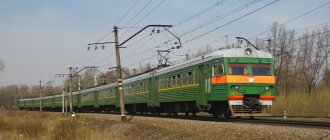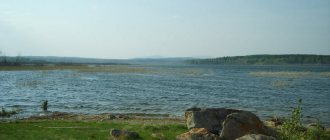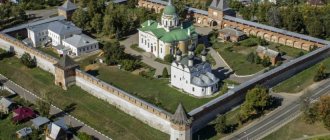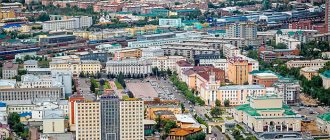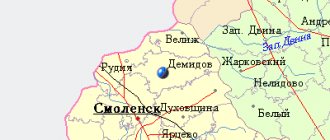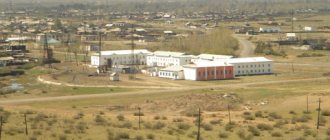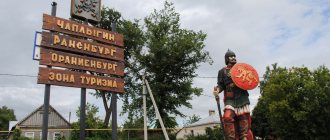City in Smolensk region, Russia
| Dorogobuzh Dorogobuzh | |
| City [1] | |
| View of Dorogobuzh. The Dnieper River is visible in the background. | |
| Flag Coat of arms | |
| Location of Dorogobuzh | |
| Dorogobuzh Location of Dorogobuzh Show map of Russia Dorogobuzh Dorogobuzh (Smolensk region) Show map of Smolensk region | |
| Coordinates: 54°55'N 33°18'E / 54.917°N W. 33.300 ° E. / 54.917; 33.300 Coordinates: 54°55'N 33°18'E. / 54.917 ° N W. 33.300 ° E. / 54.917; 33,300 | |
| A country | Russia |
| Federal subject | Smolensk region [1] |
| Administrative region | Dorogobuzhsky district [1] |
| urban village | Dorogobuzhskoye [1] |
| First mention | 1150 |
| Square [1] | |
| • General | 35.15 km2 (13.57 sq mi) |
| Height | 210 m (690 ft) |
| population size (2010 Census) [2] | |
| • General | 10 720 |
| • Evaluate (2018) [3] | 9 793 (-8,6 % ) |
| • Density | 300/km2 (790/sq mi) |
| Administrative status | |
| • Capital from | Dorogobuzhsky district [1], urban settlement Dorogobuzhskoe [1] |
| Municipal status | |
| • Municipal district | Dorogobuzhsky municipal district [4] |
| • Urban village | Urban settlement Dorogobuzhskoe [4] |
| • Capital from | Dorogobuzhsky municipal district [4], urban settlement Dorogobuzhskoye [5] |
| Timezone | UTC+3 (MSK[6]) |
| Postal code [7] | 215710, 215713 |
| OKTMO ID | 66614101001 |
| Web site | web.archive.org/web/20140714152735/http://admin.smolensk.ru/~dorogob/g_dor.html |
Dorogobuzh
(Russian: Dorogobuzh; Polish: Dorohobuż; Belarusian: Daragabuzh) is a historical town and administrative center in Dorogobuzhsky District in Smolensk Oblast, Russia, situated on the Dnieper River and located 125 km (78 mi) east of Smolensk, the administrative center of the region . Population: 10,720 (2010 census); [2] 12,250 (2002 census); [8] 12,254 people (1989 census). [9]
History[edit]
First mentioned in 1150, it was founded as a fortress protecting the eastern approaches to Smolensk. [ citation needed
] In 1508, Vasily III sent Italian craftsmen to build a wooden fort here. Dorogobuzh was ravaged during the Time of Troubles, its population reduced to ten people in 1614. Between 1611 and 1668 it was part of the Polish-Lithuanian Commonwealth as part of the Smolensk Voivodeship. It subsequently survived other foreign invasions and numerous fires.
View of the Dnieper in Dorogobuzh before 1917
Dorogobuzh was occupied by the German army during World War II, first from October 5, 1941 to February 15, 1942 (when it was liberated by three partisan detachments and some Soviet troops), then again from June 7, 1942 to September 1, 1943.
DOROGOBUZH
DOROGOBUZH, a city in Russia, in the center. parts of the Smolensk region, the center of the Dorogobuzh district. Us. 10.0 thousand people (2017). Located on the Smolensk-Moscow Upland, on the river. Dnieper, 22 km from the railway. Safonovo station. Road junction.
Dorogobuzh. Monument in memory of the Patriotic War of 1812. 1912. Administration of the Dorogobuzh District Municipal District
Holy Trinity Gerasimov Boldinsky Monastery near Dorogobuzh. Bell tower. 1580s Photo by A. P. Pyatnov
Church of the Archangel Michael in the village of Aleksino near Dorogobuzh. 1794. Architect M. F. Kazakov. Photo by A. P. Pyatnov
Founded by the Smolensk prince. Rostislav Mstislavich, probably in the 1150s. D. was first mentioned in the so-called. an additional charter “On the city and honor” of the Smolensk bishopric (1210–17), according to which it was D., of all the peripheral cities of the Smolensk princedom, who paid the bishop the largest “honor.” It arose as a fortress that defended the lands of the Smolensk princedom from the Rostov-Suzdal, and later the Vladimir, region from the east. principalities Detinets (round in plan, diameter of the site 130 m) was surrounded by a rampart (partially preserved) and a moat on the floor side. On Detinets there was a stone temple built pre-Mongol (2nd half of the 12th – early 13th centuries). It is known that there are churches in the settlement: Borisoglebskaya, Pokrovskaya, Pyatnitskaya and Trinity. Population of D. after the death of Prince. Fyodor Rostislavich Cherny refused to recognize the power of the Smolensk prince. Alexander Glebovich, who besieged the city in 1300. The residents of Dorogobuzh turned to the Vyazma prince for help. Andrei Mikhailovich, who in the battle of D. defeated the troops of the Smolensk princes Alexander and Roman Glebovich. However, the resources of D. and Vyazma were not enough for long-term resistance to the Smolensk prince. In the beginning. 14th century as a result of a new siege, D. was subjugated by the Smolensk prince, his child was completely destroyed (life was preserved only at the settlement). All R. 14th century the city was part of the domain of Fyodor Svyatoslavich, his father-in-law. book Vladimirsky Semyon Ivanovich. Some chronicle sources contain mention of the death of the Dorogobuzh prince in the Battle of Kulikovo in 1380. Vladimir Head. In 1403–04 D. became part of the Grand Duke of Lithuania. In the end 1420s – 1430s belonged to the prince. Andrei Dmitrievich, a native of the Tver Rurikovichs, who was in Lithuania. service. After 1440 it was transferred to the possession of the Lithuanians. magnates Gashtold. In June 1500, during the Rus.-Litov. wars of 1500–03, D. was occupied by the Russians. troops, according to the Moscow Truce of 1503 remained part of the Russian Federation. state During the Russian-Lithuanian Wars of 1507–08 briefly occupied Lithuania. troops. In 1508–1509, by order of the leader. book Vasily III Ivanovich of Moscow sent Italians from Moscow to build a new fortress in D. masters Bartolomeo Fryazin (Bartolomey) and probably Bon Fryazin (Mastroban).
At 16 – start. 17th centuries D. was one of the most important fortresses and a gathering point for Russians. troops to the west borders of Rus. state, including during the Livonian War of 1558–83. During the Time of Troubles it changed hands several times. In 1617 it was captured by the troops of Prince Vladislav (the future Polish king Vladislav IV) and, under the terms of the Deulin Truce of 1618, remained part of the Polish-Lithuanian Commonwealth. During the Smolensk War of 1632–34, Russian was taken. troops and became chief. a stronghold for the offensive of the army of governor M.B. Shein towards Smolensk. However, according to the Polyanovsky Peace of 1634, the Polish-Lithuanian Commonwealth was returned. In the 17th century The Danish fortress included three wooden-earth castles (“cities”) connected together, surrounded by a rampart and a moat (the length of the walls was 1.2 km; according to various descriptions, there were 13–14 towers; the earthen fortifications of the “upper city” were partially preserved). In 1654, during the Russian-Polish war 1654–67, D. taken by Russian. troops and under the terms of the Truce of Andrusovo in 1667 became part of Russia. state Gradually lost important military. significance in connection with the return to Rus. state and Smolensk.
County town of Smolensk (1708–13, 1726–1927; in 1775–96 – Smolensk governorship) and Riga (1713–26) provinces. In the 18th century large shopping center. In 1724 and 1763 the center. part of the city was destroyed by fires. In 1765, a regular plan for the development of D. was approved. Bo time Otech. war of 1812 D. (in August) occupied by the French. troops. Released 26 Oct. (7 Nov.) russian vanguard under command. gene. from inf. M. A. Miloradovich. All R. 19th century in D. were mainly small processing enterprises. Trade in bread, hemp, flaxseed and hemp developed. In 1861, the first in the Smolensk province was created in D. women's school.
On October 26 (November 8), 1917, the Soviet Union was proclaimed in D. power. In 1927–29, the volost center of Yartsevsky district. In 1929–37, the regional center of the Western region, in 1937–63 and from 1965 – of the Smolensk region. In Vel. Otech. During the war the city was occupied by Germany. troops (8.10.1941). Liberated on February 15, 1942 by partisans (detachments “Uragan”, “Grandfather”, “Grandfather”, “Chaika”) during the Rzhev-Vyazma operation of 1942. In the beginning. 1942 the center of the vast Dorogobuzh partisan region, defended by partisans and units of the 4th Guards. airborne corps of the Red Army. Germany is re-occupied. troops 8.6.1942. Released on September 1, 1943 during the Elninsk-Dorogobuzh operation of 1943. At the end. 1950s In connection with the construction of the Dorogobuzh State District Power Plant, 7 km from D., the Dorogobuzh industrial center was formed, which, along with D., included the village. mountains type Verkhnedneprovsky, formed in 1956. In 1963–65 as part of the Safonovsky district. In the beginning. 2000s Dorogobuzhsky district is one of the most industrially developed areas of the Smolensk region.
Among the architectural monuments: St. Demetrius Church (early 18th century), former. salt barn building (2nd half of the 18th century; now the regional Museum of History and Local Lore, opened in 1919), c. Apostles Peter and Paul (1835), mountains. estate of the merchants Sveshnikov (late 19th century), formerly building of the district zemstvo government (late 19th - early 20th centuries), hospital town (late 19th - early 20th centuries). Monuments: monument in memory of the Fatherland. war of 1812 on the mountains. the rampart (built in 1912); T-34 tank, installed in honor of the liberation of D. by units of the Red Army.
Representative office of Russia new university College of Management (2002).
Enterprises in the food industry, lumber production, etc. Forestry.
Near D., in the village. mountains type Verkhnedneprovsky, - enterprises: Dorogobuzh (part of the Acron group; mineral fertilizers, etc.), Dorogobuzhkotlomash (large manufacturer of hot water boilers), Polimerkrovlya-Dorogobuzh (soft roofing materials), Dorogobuzhskaya CHPP (introduced put into operation in 1957 as a state district power station; approx. 130 MW).
15 km east of D., in the village. Boldino, there is one of the oldest monastic ensembles in the Smolensk region - the Holy Trinity Gerasimov Boldino Monastery, founded by St. Gerasim Boldinsky in 1530 (closed in 1929, reopened in 1991). Basic the structures were created in the 1580s–90s, but during the Great Otech. war in March 1943 the Germans were blown up. troops. In 1964–69, under the direction of P. D. Baranovsky restoration work was carried out. work has been continued since 1969 under the supervision of A. M. Ponomareva. By 2007, the refectory with the c. Introductions (1966–2003, with a wooden tent instead of a stone one and 6 m lower than it), a bell tower (1977–88), and also built in the 1770s. fence and Tikhonovskaya Church. 2nd floor 19th century on the site of the cell of St. Gerasim Boldinsky (1993). The restoration of the Trinity Cathedral continues (started in 2005). 18 km southeast of D. is located the former. The Baryshnikov estate Aleksino is the largest architectural and park ensemble in the Smolensk region. M. F. Kazakov probably took part in the design (Church of St. Michael the Archangel, 1794; St. Andrew's Fortress in the pseudo-Gothic style, between 1798 and 1810; residential outbuildings, stables and a complex of outbuildings, 1770–80s) and D. I. Gilardi (palace, 1819–23; Music Pavilion, between 1818 and 1824). The estate park consists of three parts: the original regular park itself (late 18th – early 19th centuries), which has now turned into a landscape park, the Upper and Lower parks (a system of open glades connected by a network of paths, separated by sparse groups of trees).
Links[edit]
Notes[edit]
- ^ abcdefghi Resolution No. 261
- ^ a b Federal State Statistics Service (2011). “All-Russian Population Census 2010. Volume 1" [All-Russian Population Census 2010, vol. 1]. All-Russian Population Census 2010 [All-Russian Population Census 2010]
. Federal State Statistics Service. - "26. The size of the permanent population of the Russian Federation by municipalities as of January 1, 2022". Federal State Statistics Service. Retrieved January 23, 2022.
- ^ abcd Law No. 107-z
- Federal State Statistics Service. Federal Agency for Technological Regulation and Metrology. No. OK 033-2013 January 1, 2014 “All-Russian classifier of municipal territories. Code 66 614 101 ". (Federal State Statistics Service. Federal Agency for Technological Regulation and Metrology. No. OK 033-2013 dated January 1, 2014. Russian classification of municipal territories. Code 66 614 101.
). - "On the Calculation of Time". Official Internet portal of legal information
. June 3, 2011. Retrieved January 19, 2022. - Post office. Information and computing center of OASU RPO. ( Post office
).
Search for postal service objects ( postal Search for objects
) (in Russian) - ↑
Federal State Statistics Service of Russia (May 21, 2004).
“The population of Russia, the constituent entities of the Russian Federation as part of federal districts, urban settlements, settlements, settlements of 3 thousand or more people” [Population of Russia, its federal districts, federal districts, districts, urban settlements, rural settlements - administrative centers and rural settlements with a population of more than 3,000 people] (XLS). All-Russian Population Census of 2002 [All-Russian Population Census of 2002]
. - “All-Union Population Census of 1989. The actual population of the union and autonomous republics, autonomous regions and districts, territories, effects, urban settlements and villages-paradiseConsultant-plus.” (Administration of the Smolensk region. Resolution No. 261 of April 30, 2008 “ On approval of the Register of administrative-territorial units and territorial units of the Smolensk region”
as amended by Resolution No. 464 of June 27, 2014 “
On amendments to the Register of administrative-territorial units of the Smolensk region"). Administrative-territorial units and territorial units of the Smolensk region
). - Smolensk Regional Duma. Law No. 107-z of December 20, 2004 “On granting the status of a municipal district to the municipal formation” Dorogobuzhsky district “of the Smolensk region, on establishing the boundaries of municipalities whose territories are part of it, and granting them status,” as amended. Law No. 86-z of October 31, 2011 “On Amendments to the Regional Law” On granting the status of a municipal district to the municipal formation “Dorogobuzhsky District” of the Smolensk Region, on establishing the boundaries of municipalities whose territories are part of it, and granting them the corresponding status "". Came into force on the date of official publication. Published: “Bulletin of the Smolensk Regional Duma and Administration of the Smolensk Region”, No. 13, part II, p. 89, December 22, 2004 (Smolensk Regional Duma. Law No. 107-z of December 20, 2004 “On assignment to a municipal entity” Dorogobuzhsky district “of the Smolensk region the status of a municipal district”, on establishing the boundaries of municipalities on the territory of which it is located “On assigning them the appropriate status”
as amended by the Law of October 31, 2011 No. 86-Z “
On amendments to the regional law "On assigning the status of a municipal district to the municipal formation "Dorogobuzhsky district" of the Smolensk region." Establishing the boundaries of municipalities, the territories of which they are included, and assigning them the appropriate status
. "Valid from the date of official publication.).
External links [edit]
- Official website of Dorogobuzh (in Russian)
- Unofficial site Dorogobuzh (in Russian)
- Mozhgorod.ru. Entrance to Dorogobuzh (in Russian)
| vteAdministrative divisions for the Smolensk region | |||
| Administrative center: Smolensk • Rural area. | |||
| Districts |
| ||
| Cities and towns |
| ||
| Urban settlements |
| ||
Dorogobuzh
Employees of the regional historical and local history museum summarized data on the sights of Dorogobuzh (a large-scale media library was created) to introduce a tourist navigation system using QR codes, developed and tested 7 tourist routes around the city and region that connect cultural heritage sites - monuments of archaeology, architecture, history . More than 90 excursions are conducted annually as part of domestic and inbound tourism.
Cultural and historical routes: “Dorogobuzh - an ancient city, a glorious city” and “Dorogobuzh - a city of partisan glory” within the city combine the most interesting objects: the memorial complex “Val” - the earthen rampart of the Dorogobuzh fortress and a memorial to soldiers who died defending the Fatherland; St. Demetrius Convent of the 19th century. Among the objects of architectural heritage, the attention of tourists is attracted by the city estate of the Sveshnikov merchants - a complex of buildings from the 2nd half of the 19th century. (a two-story house and three one-story outbuildings), an ensemble rare in its completeness and preservation, typical of the eclecticism of the late 19th century. "brick" style. During the Great Patriotic War in 1942, the headquarters of the 1st Guards Cavalry Division was located here. In the center of Dorogobuzh, the building of a former salt barn has been restored. This is one of the first buildings in the city erected according to the regular development project (1770s). Nowadays the Civil Registry Office (Wedding Palace) is located here. Tourists are also interested in the fact that in 1963, on the banks of the Dnieper in the vicinity of Dorogobuzh, battle scenes of the world famous film “War and Peace” (directed by S.F. Bondarchuk) were filmed. A memorial sign was erected at the filming site in 2013. The traditions of Orthodoxy are still strong in the city, so when visiting it during the cultural and religious route “Orthodox shrines of the land of Dorogobuzh”, guests get acquainted with the city’s churches. In the eastern part of the city (Dmitrievsky Val), on a high hill, there is the St. Dimitrievsky Convent, operating since 1998. At the temple there are buildings from the beginning of the 18th century, buildings of a hospital complex (the turn of the 19th-20th centuries). The Church of Peter and Paul, built in 1835, has been in operation since 1988. During the Great Patriotic War, this church, the only one of all Dorogobuzh churches, escaped destruction. After the war, the church building was used as a warehouse. The permanent rector of the temple is Archpriest Nikolai Kanchuk. In Dorogobuzh, in the courtyard of the Holy Trinity Boldin Monastery, since 2000 there has been a wooden church in the name of the Kazan Icon of the Mother of God. Historical and educational routes: - “Dorogobuzh - an ancient city, a glorious city”; — “Dorogobuzh – the city of partisan glory”; — 2-day route “Along the Old Smolensk Road”; — “Living Memory of Past Years” (through the historical sites of the Battle of Vedrosh in 1500) with a visit to the estate of the Baryshnikov nobles; — “The unique noble estate of the Baryshnikovs in the village of Aleksino; cultural, religious and pilgrimage routes: - “Orthodox shrines of the Dorogobuzh land.” Monasteries and temples of Dorogobuzh; — “Orthodox shrines of the land of Dorogobuzh.” Holy Trinity Boldin Monastery.
